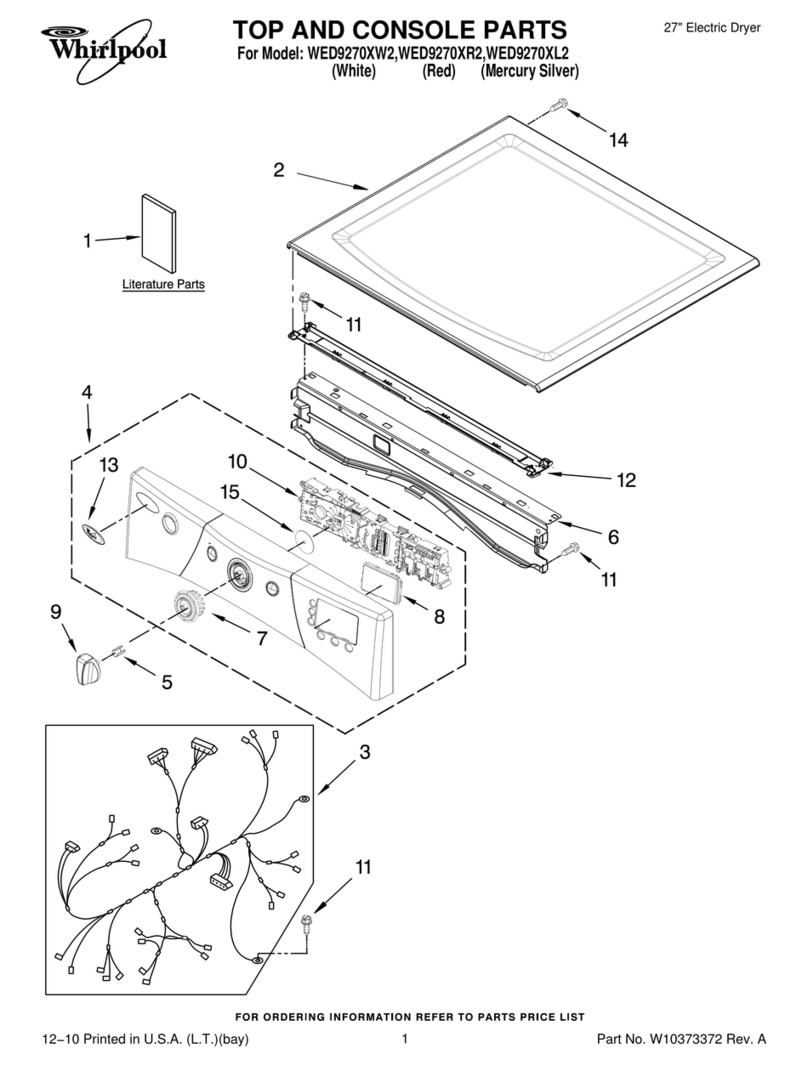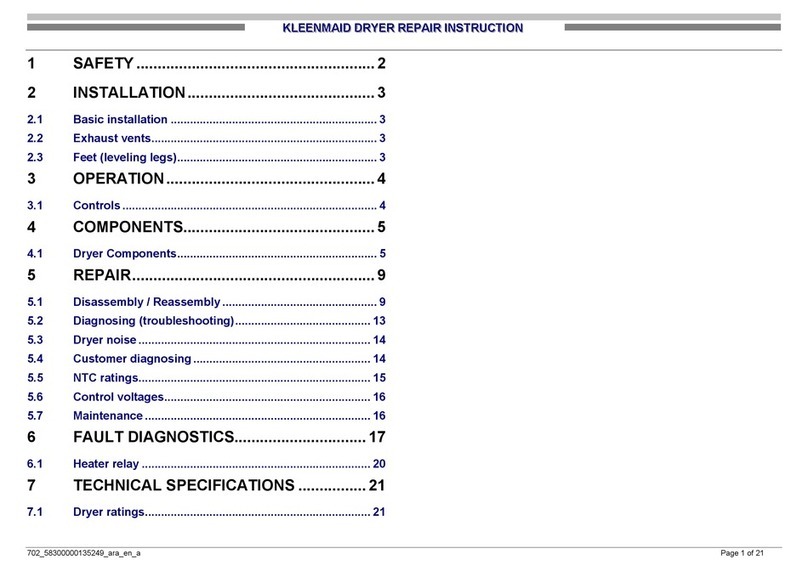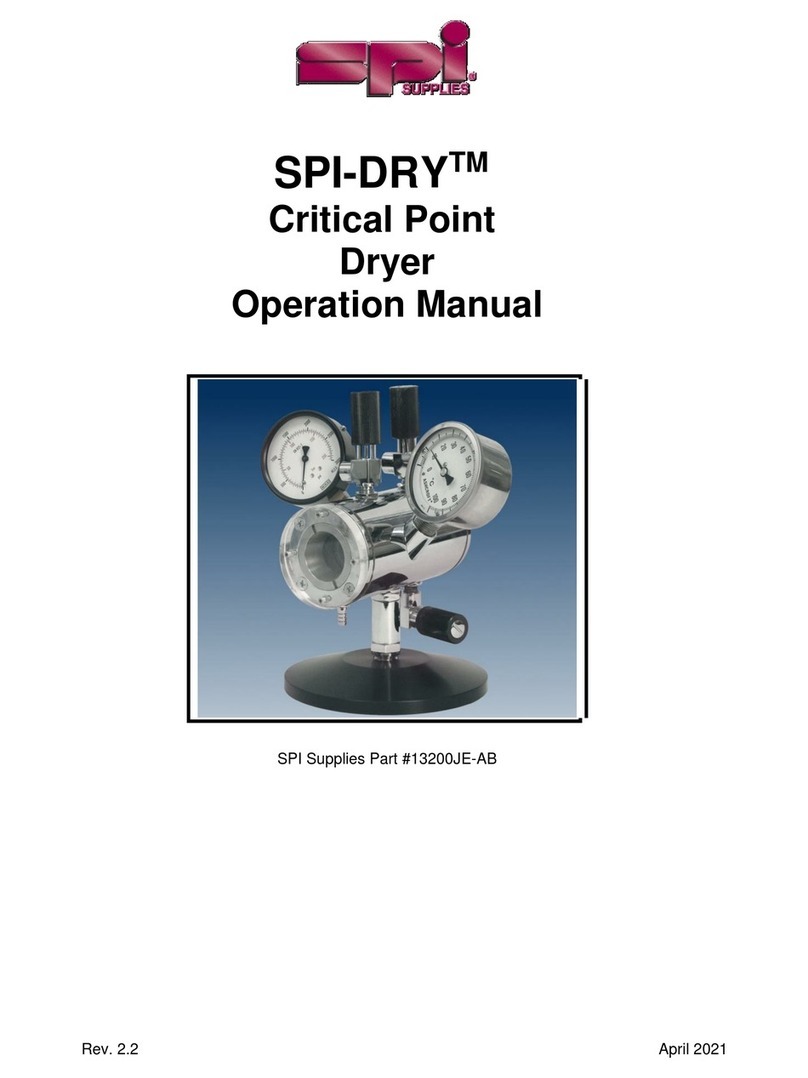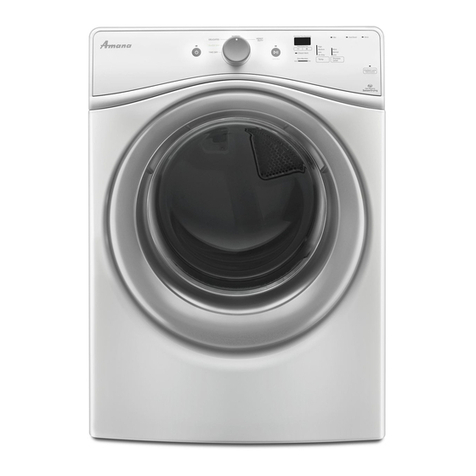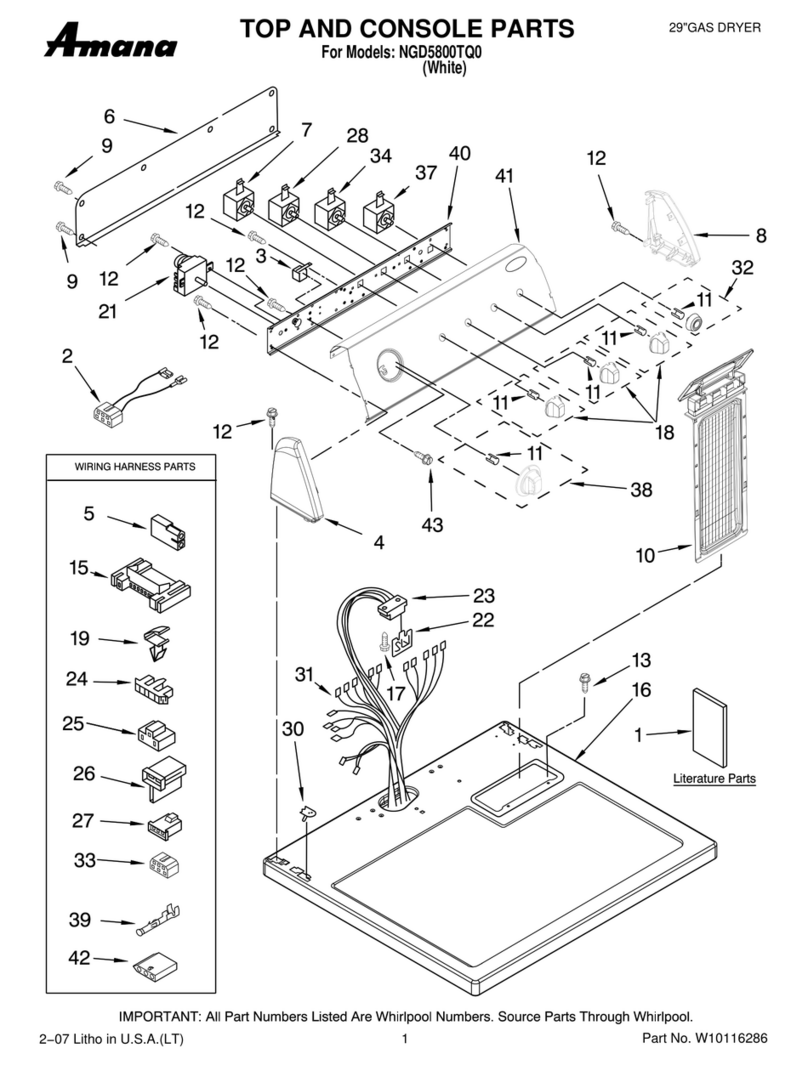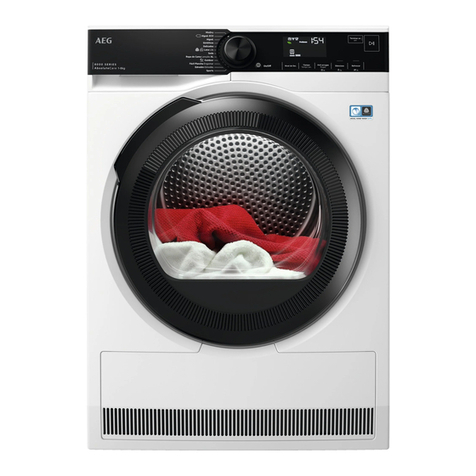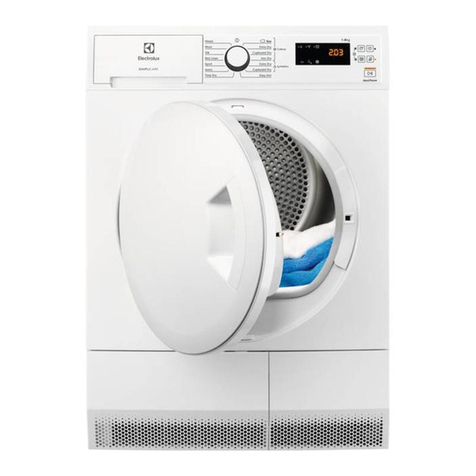General Domestic Appliances T312VW User manual

Tumble Dryer
Instruction Book
3kg Models
You must read these instructions prior to using the appliance and
retain them for future reference.

2
This appliance conforms to the following EEC Directives:
Low Voltage Equipment
73/23/EEC
93/68/EEC
Electromagnetic Compatibility
89/336/EEC
92/31/EEC
93/68/EEC
DISPOSAL OF YOUR PRODUCT
To minimise the risk of injury to children please dispose of your product carefully and
safely. Remove all doors and lids (where fitted). Remove the mains cable (where
fitted) by cutting off flush with the appliance and always ensure that no plug is left in
a condition where it could be connected to the electricity supply.
To help the environment, Local Authority instructions should be followed for the
disposal of your product.

A tumble dryer gently tumbles the wet clothes in a current of
warm air after they have been spun in a washing machine or spin
dryer. Moisture is evaporated until the clothes are quite dry, much
like a speeded up version of what takes place outdoors in a fresh
breeze on a fine sunny day, in a clean fresh atmosphere.
A good tumble dryer reduces unwanted creases as it dries, creases
that may have been put in during spinning. Drip-dry shirts dried
in a dryer will be more crease-free than the same shirt given the
same wash treatment and hung up to dry. Most materials will
benefit from this effect, including cottons and linens, synthetic
materials and mixtures of both. In some cases the need to iron will
be eliminated, but it is important in order to achieve the maximum
benefit that you should not overload the dryer. It is better to dry
two small loads rather than one large load if crease removal is
important. This will use slightly more electricity in drying than one
large load, but will save on ironing. If you must iron then the
maximum loadings given in the instructions will give the greatest
efficiency in use of electricity.
Towels will be soft and bulky after drying in a tumble dryer,
nappies will be smooth and fluffy, unlike the same articles which
tend to be flattened and stiff when dried statically. Garments may
be quickly aired after storage or warmed before use. Many
fabrics used in the manufacturing of clothing and household
textiles tend to undergo some change of size when laundered.
This size change is due to relaxation of the fibres, which have bee
n
stretched during spinning and weaving, and which tend to return
to their unstretched state when immersed in water. These fibres
are normally stretched again in use, and even hanging wet on a
line stretches the material to some extent. Tumble drying does not
put tension on the fabrics as line drying does, and the difference
may therefore appear more noticeable when garments are dry.
The following may be obtained as optional extras for use with
your dryer.
Always quote the serial number and model number of your dryer
as stated on the rating plate when ordering any kits.
Exhaust Kit 38403 (see page 7)
Extended Exhaust Kit 1741057
Wall/Window Kit 38407 (see page 7)
Wall Hanging Kit 38501A (see page 7)
Note: Be sure to use only genuine accessories. There are items available
manufactured by other companies which it is claimed will fit our
products, but these may not fit satisfactorily and can impair the
performance.
What a Tumble Dryer Does
Optional Extras
3

Cautionary Notes
IMPORTANT Before operating your machine read the cautionary notes below
and familiarise yourself with the way it works by carefully reading
these instructions.
NEVER – Allow children to play with or otherwise interfere with
the dryer.
NEVER – Allow the air inlet at the back of the dryer, the air outlet
or vent hose to be obstructed.
NEVER – Direct the vent hose outlet towards the air intake at the
back of the machine. The tumble dryer must not recycle
exhaust air.
NEVER – Switch the machine off leaving a hot load in the drum.
NEVER – Tumble dry without the filter in position.
NEVER – Exceed the maximum load capacity recommended or
place dripping wet items in the drum.
NEVER – Use the dryer on a carpeted floor where the pile height
would prevent air from entering the dryer from the base.
NEVER – Allow lint to collect around the dryer.
NEVER – Use the dryer for commercial drying, the dryer is only
suitable for domestic use.
NEVER – Discharge the exhaust air into a flue which is used for
exhausting fumes from other appliances burning gas or other
fuels.
In order to NEVER – Tumble dry articles that have NOT been well washed in
alleviate water and detergent then well rinsed and spun.
fire hazards: NEVER – Dry articles that are contaminated with flammable substances
such as:–
Petrol, Oil, Paint,
Cleaning Solvents, Wax,
Hair Lacquer, Creams,
Cooking Fat or Oil.
NEVER – Tumble dry articles that have had chemicals used for cleaning.
NEVER – Tumble dry :–
Rubber, Foam Rubber, Plastic.
Plastic Foam, Nappy Pants or Liners,
Polythene or Paper
Any dry cleaned garments.
Large, very bulky items including duvets and
sleeping bags.
Items not recommended for tumble drying, are
marked
4

ALWAYS – When the dryer is not in use, switch off at the wall,
remove plug, close the door.
ALWAYS – Comply with the specified electrical requirements.
ALWAYS – Ensure that your dryer is installed correctly and has
adequate ventilation. (See page 7).
ALWAYS – Terminate every programme with the cool cycle
provided on the timer.
ALWAYS– Clean the filter, it is essential that the filter is kept
clear of fluff at all times (See Page 9).
ALWAYS – Observe the rules for drying woollen garments:
Woollen articles should not be dried in a tumble dryer
unless they are labelled ‘Superwash’, ‘Machine-wash-
able’ or have the May be tumble dried Symbol
If in any doubt do not tumble dry wool.
Unlike other materials, the mechanism of wool shrink-
age is irreversible, i.e. it will not stretch back to original
size and shape.
ALWAYS – Buy genuine accessories and spares.
CAUTIONARY
NOTE –
CHILDREN:
Cautionary Notes
5
A CHILD COULD CLIMB INTO AN UNATTENDED TUMBLE DRYER.
WHEN THE MACHINE IS NOT IN USE SWITCH OFF AT THE WALL
SOCKET, REMOVE THE PLUG AND CLOSE THE DOOR.
WARNING: When operating the dryer, there has to be adequate
ventilation to avoid the back flow of gases into the room from
appliances burning other fuels, including open fires.
CAUTION:
When the dryer is in use avoid touching the rear of
the dryer as it may be hot!
Table of contents
Popular Dryer manuals by other brands

ffuuss
ffuuss eos user manual

KitchenAid
KitchenAid 53-3498 installation instructions

Schulthess
Schulthess Spirit topLine TW 8340 operating instructions
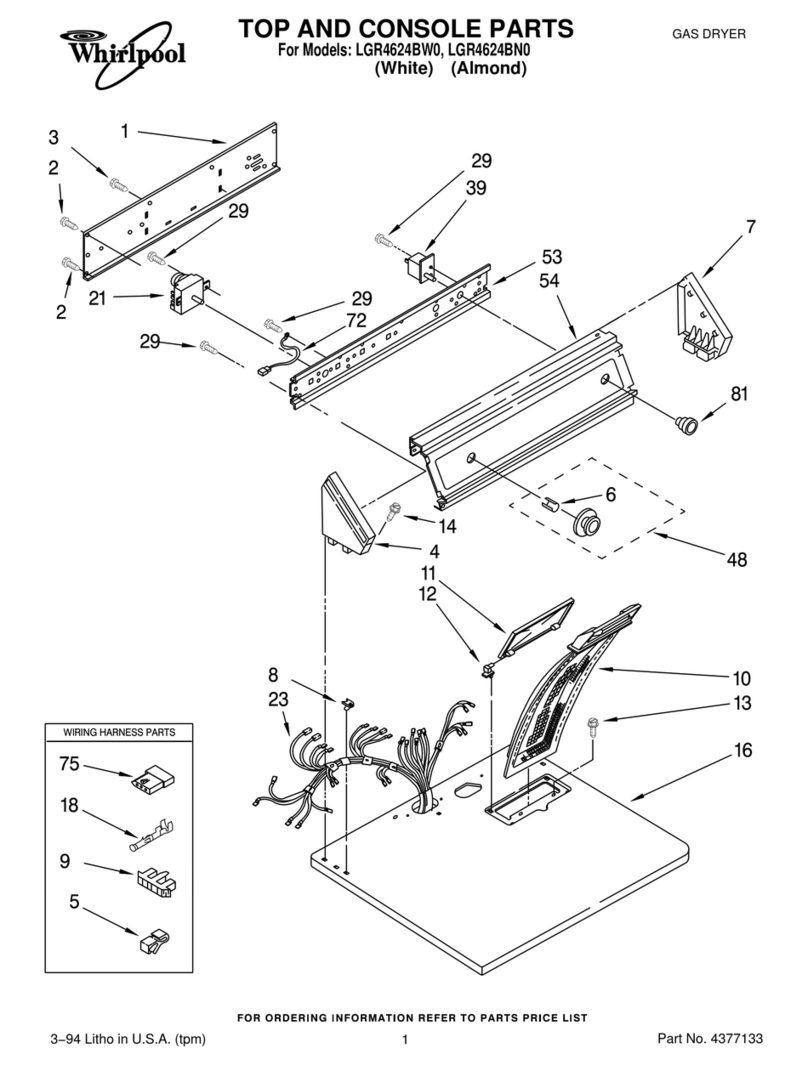
Whirlpool
Whirlpool LGR4624BW0 parts list
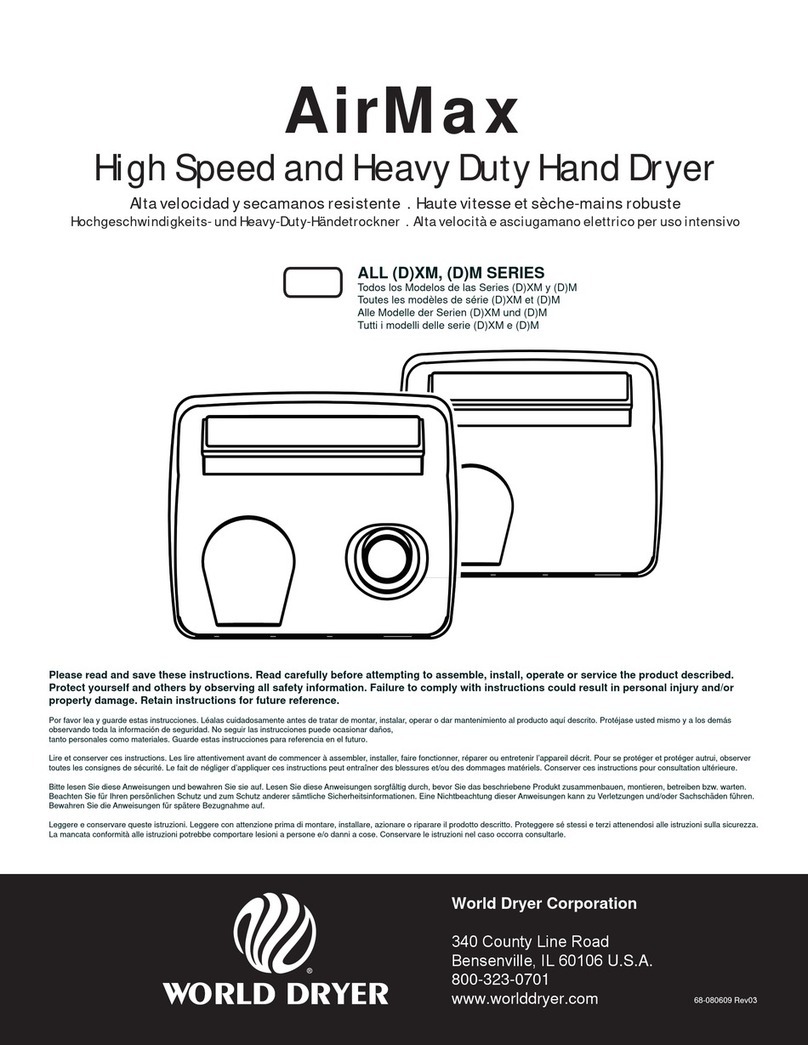
World Dryer
World Dryer AirMax D M5-972A manual
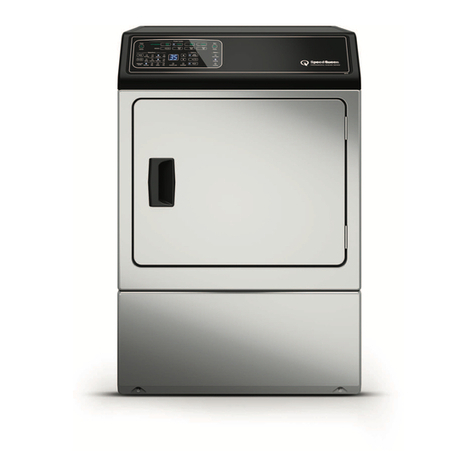
Alliance Laundry Systems
Alliance Laundry Systems ADEE9BSS user guide
